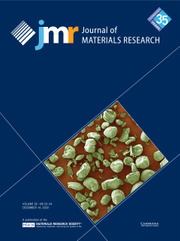Crossref Citations
This article has been cited by the following publications. This list is generated based on data provided by Crossref.
Yamanaka, Shinsuke
Kobayashi, Hirokazu
and
Kurosaki, Ken
2003.
Thermophysical properties of layered rare earth copper oxides.
Journal of Alloys and Compounds,
Vol. 349,
Issue. 1-2,
p.
269.
Korshunov, M M
Zakharova, E V
Nekrasov, I A
Pchelkina, Z V
and
Ovchinnikov, S G
2010.
The Fermi surface and the role of electronic correlations in Sm2−xCexCuO4.
Journal of Physics: Condensed Matter,
Vol. 22,
Issue. 1,
p.
015701.
Lysenko, V. A.
2011.
Thermodynamic analysis of phase equilibria in the Sm-Cu-O system.
Inorganic Materials,
Vol. 47,
Issue. 8,
p.
884.
Denisov, V. M.
Denisova, L. T.
Chumilina, L. G.
and
Kirik, S. D.
2013.
High-temperature heat capacity of Sm2CuO4 and Ho2Cu2O5.
Physics of the Solid State,
Vol. 55,
Issue. 10,
p.
2023.
Konsolakis, Michalis
Carabineiro, Sónia A.C.
Tavares, Pedro B.
and
Figueiredo, José L.
2013.
Redox properties and VOC oxidation activity of Cu catalysts supported on Ce1−xSmxOδ mixed oxides.
Journal of Hazardous Materials,
Vol. 261,
Issue. ,
p.
512.
Denisova, L. T.
Chumilina, L. G.
and
Denisov, V. M.
2014.
Heat capacity of Ln 2CuO4 (Ln = La-Gd) cuprates.
Physics of the Solid State,
Vol. 56,
Issue. 9,
p.
1928.
Konsolakis, Michalis
and
Ioakeimidis, Zisis
2014.
Surface/structure functionalization of copper-based catalysts by metal-support and/or metal–metal interactions.
Applied Surface Science,
Vol. 320,
Issue. ,
p.
244.
Korina, Elena
Karaberova, Arina
Bulatova, Ekaterina
Golovin, Mikhail
Stankovich, Dalibor M.
Gusev, Sergei
Fadeev, Vladislav
and
Bol’shakov, Oleg
2025.
Samarium cuprate with micron-size pores for drug sensing.
Journal of Chemical Sciences,
Vol. 137,
Issue. 1,

